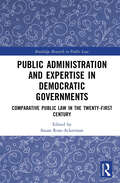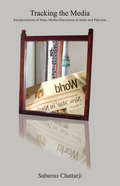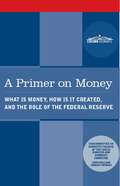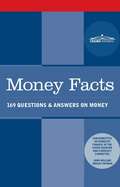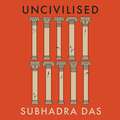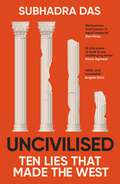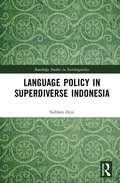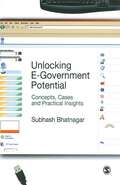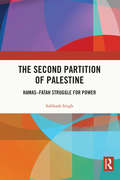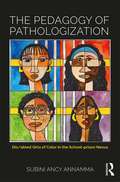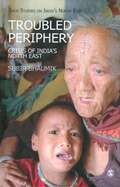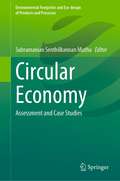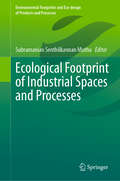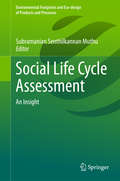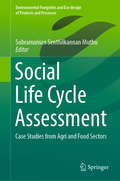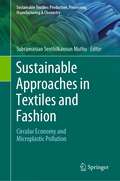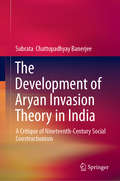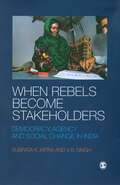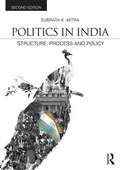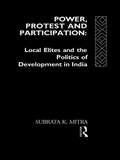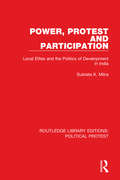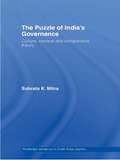- Table View
- List View
Public Administration and Expertise in Democratic Governments: Comparative Public Law in the Twenty-First Century (Routledge Research in Public Law)
by Suan Rose-AckermanThis collection deals with challenges confronting public law and public administration in twenty-first century democracies across the world. It draws together contributions from leading scholars, examining cutting-edge topics, and projecting the scholarship forward. It emphasizes the importance both of justifying executive policymaking to citizens and of drawing on bureaucratic expertise and professional competence. Contributors examine the role of courts and argue for new forms of public participation that can incorporate democratic values into executive-branch policymaking. Finally, the work confronts problems in the administration of the criminal law that are generating increased public concern. Building on Rose-Ackerman’s scholarship, writers compare the American experience with contemporary developments in other leading democracies – in particular, Germany, France, the EU, Canada, and Latin America. The work will be an invaluable resource for academics, researchers and policymakers working in the areas of Administrative Law, Public Law, and Political Science.
Tracking the Media: Interpretations of Mass Media Discourses in India and Pakistan
by Subarno ChattarjiThis book is about media content analysis in the English language print media in South Asia, with reference to certain contemporary issues. It is written from the perspective of the need to analyze media discourses and the ways in which their circulation creates a ‘common sense’ view of the world. The focus is on English language papers and news magazines; additionally, some Hindi, Urdu, and Sindhi newspapers are examined. The highlight is on the ways in which English language publications contribute to and function within middle class matrices of modernity, consumption, conflict, and conservatism in India.
Standing Operating Procedures for Developing Acute Exposure Guideline Levels for Hazardous Chemicals
by Subcommittee on Acute Exposure Guideline LevelsStanding Operating Procedures for Developing Acute Exposure Guideline Levels for Hazardous Chemicals contains a detailed and comprehensive methodology for developing acute exposure guideline levels (AEGLs) for toxic substances from inhalation exposures. The book provides guidance on what documents and databases to use, toxicity endpoints that need to be evaluated, dosimetry corrections from animal to human exposures, selection of appropriate uncertainty factors to address the variability between animals and humans and within the human population, selection of modifying factors to address data deficiencies, time scaling, and quantitative cancer risk assessment. It also contains an example of a summary of a technical support document and an example of AEGL derivation. This book will be useful to persons in the derivation of levels from other exposure routes—both oral and dermal—as well as risk assessors in the government, academe, and private industry.
A Primer on Money
by Subcommittee on Domestic FinanceThe above quote was from a 1941 speech by U.S. congressman Wright Patman, a fierce critic of the Federal Reserve. A Primer on Money, released in 1964 by the Congressional Subcommittee on domestic finance, explains in Patman’s introduction “in simple, everyday language how the US monetary system works and indicates where it needs reform.” It describes specifically: - What is money? - How is money created? - The role of the Federal Reserve System - Money supply and Monetary policy - Improvements in the Money System Although this publication is over fifty years old and changes have been made to the Federal Reserve System since then, it is a testament to Patman’s insights that this report is still relevant and important to today’s discussion about the role of the Federal Reserve in the U.S. economy. This report is essential reading for students of monetary policy, academics, policymakers, journalists, and anyone interested in learning about the basics of money and the Federal Reserve.
Money Facts: 169 Questions & Answers on Money
by Subcommittee on Domestic FinanceThe meaning of money, how it was created, and how it influenced everyday life for Americans inspired Wright Patman throughout his professional life as a Congressman from 1928 to 1975, as chairman of the powerful United States House Committee on Banking and Currency from 1963 to 1975 and a life-long populist in the good sense of the word. He defended the little guy, farmers, veterans and small businessmen against big business, big chain stores, big banks and especially the Federal Reserve system. Together with his Subcommittee on Domestic Finance, Patman released in 1964 A Primer on Money explaining how the US monetary system works and indicated where it needed reform. As a supplement to that report, he released Money Facts—169 Questions and Answers on Money, which is designed to highlight in question and answer form the basic points brought out in A Primer on Money. It answers, for example, what money is: “Money is anything that people will accept in exchange for goods or services, in the belief that they may, in turn, exchange it, now or later, for other goods or services,”, but it also raises many other questions such as: - Who issues currency? - What is a central bank? - What is active monetary policy? - What is the main problem of the Federal Reserve System? Although this publication is over fifty years old, and some changes have been made to the Federal Reserve System since then, this booklet is still relevant and important to understand more about the history and meaning of money and how the Federal Reserve System plays a crucial role in the US economy. This report is interesting reading for students of monetary policy, academics, policymakers, journalists, and anyone interested to learn about the basics of money and the monetary system.
Uncivilised: Ten Lies that Made the West
by Subhadra DasSome things are a given. The value of a good education. Time's progress. Death.Except most of the ideas that form Western Civilisation are just that - ideas. Taking cues from Greek philosophy and honed in the Enlightenment, certain notions about humanity and human society grew into the tenets we live by, and we haven't questioned them a great deal since. But isn't it time we asked who really benefits from the values at the core of our society? How much truth lies in a science that conjured up 'race'? Who do laws and nations really protect? Why does it feel like time is money? What even is 'art'?And the real question - is the West really as 'civilised' as it thinks it is?This audiobook will put everything back on the table and ask listeners to reconsider what they thought they knew about civilisation. Taking 10 core values of Western Civilisation in turn, it will examine the root of the idea, how it developed, and how it's impacted the way we live. Most importantly it will reveal how each of these ideas was either created in opposition to another group of people, or based on ideas they had first (and better). (Un)civilised will ask listeners to open their eyes to the why behind how they think the world works.(P) 2024 Hodder & Stoughton Limited
Uncivilised: Ten Lies that Made the West
by Subhadra DasPre-order the enthralling and radical book that overturns our assumptions about civilisation and society'A witty and accessible survey of the shortcomings of western civilisation as many people imagine it' ANGELA SAINI, author of Superior'A vital piece of work in our challenging times that reminds us of the rich history and influences outside the West. Das writes with passion and humour to open our eyes to the history that has shaped our world' ROMA AGRAWAL, author of Built and Nuts and Bolts___________Some things are a given: knowledge is power, time is money, justice is blind. But many of the big ideas that underpin Western civilisation are just that - ideas. Taking cues from Greek philosophy and honed in the Enlightenment, certain notions about humanity and society grew into the tenets we still live by today, and we haven't questioned them a great deal since.But what if they're not just ideas? What if they're outright lies? Isn't it time we asked who really benefits from the values at the core of our society? What is unbiased about a science that conjured up 'race'? Who do laws and nations actually protect? What even is 'art'? And the real question: is the West really as 'civilised' as it thinks it is?Uncivilised puts everything back on the table and asks readers to reconsider what they thought they knew about civilisation, starting with the ten lies that have shaped their lives.
Language Policy in Superdiverse Indonesia (Routledge Studies in Sociolinguistics)
by Subhan ZeinIndonesia has an extreme diversity of linguistic wealth, with 707 languages by one count, or 731 languages and more than 1,100 dialects in another estimate, spoken by more than 600 ethnicities spread across 17,504 islands in the archipelago. Smaller, locally used indigenous languages jostle for survival alongside Indonesian, which is the national language, regional lingua francas, major indigenous languages, heritage languages, sign languages and world languages such as English, Arabic and Mandarin, not to mention emerging linguistic varieties and practices of language mixing. How does the government manage these languages in different domains such as education, the media, the workplace and the public while balancing concerns over language endangerment and the need for participation in the global community? Subhan Zein asserts that superdiversity is the key to understanding and assessing these intricate issues and their complicated, contested and innovative responses in the complex, dynamic and polycentric sociolinguistic landscape of Indonesia that he conceptualises as superglossia. This offers an opportunity for us to delve more deeply into such a context through the language and superdiversity perspective that is in ascendancy. Zein examines emerging themes that have been dominating language policy discourse including status, prestige, corpus, acquisition, cultivation, language shift and endangerment, revitalisation, linguistic genocide and imperialism, multilingual education, personnel policy, translanguaging, family language policy and global English. These topical areas are critically discussed in an integrated manner against Indonesia’s elaborate socio-cultural, political and religious backdrop as well as the implementation of regional autonomy. In doing so, Zein identifies strategies for language policy to help inform scholarship and policymaking while providing a frame of reference for the adoption of the superdiversity perspective on polity-specific language policy in other parts of the world.
Unlocking E-Government Potential: Concepts, Cases and Practical Insights
by Subhash BhatnagarUnlocking E-Government Potential: Concepts, Cases and Practical Insights serves as a practical guide for conceptualizing and implementing e-government at the local, state and national levels and provides an overview of the global experience in implementing the same. This book is a sequel to the author′s earlier book, E-Government: From Vision to Implementation. It describes the evolution of e-government applications over a period of four years through cases and illustrations and explores its potential impact on cost of access, quality of service and quality of governance for citizens and businesses, and on transparency and corruption. The book presents empirical results from impact assessment studies done during 2006–08 for nearly 50 e-government projects. Among other issues, it discusses the strategy for making e-government work for the poor. The case studies of e-government applications cover a wide range—serving different types of clients, focusing on different purposes, and built by different tiers of government. These cases explain the application context, new approaches embodied in the e-government application, challenges faced during implementation, benefits delivered and costs incurred. This book will be of interest to management professionals and those with a public administration background. It will also be very useful for students enrolled in university programmes dealing with ICT and development and international academic courses on e-governance.
Hamari Sansad
by Subhash KashyapBest book available in the Market to understand Indian Constitution. Kashyap has been the pioneer writer on Indian Constitution and topmost commentator on different aspects of constitutions. For a student in university or for an aspirant preparing for civil services exam. This is the most important book.
The Second Partition of Palestine: Hamas–Fatah Struggle for Power
by Subhash SinghThis book examines the factors and issues responsible for the intra-Palestinian conflict that has undermined the strength and vitality of the struggle for liberation against the state of Israel. It explores how the ideological incompatibility and competition for political primacy account for the Hamas–Fatah conflict, entailing the risk of partition of Palestine even before it takes shape as an independent, sovereign entity. It analyzes the developments since the signing of the September 1993 Oslo Accord and discusses themes such as the background of Palestinian politics; the role of Fatah; the rise of Hamas as Fatah’s political rival; the Hamas–Fatah struggle for power; and the role played by the international community, including by the US and the European Union. The study deals with the various facets of territorial and political challenges faced by the rival Palestinian actions; the failure of the reconciliation efforts by Egypt and Yemen; the stalled peace process in the West Bank and Gaza Strip; the emergence of the Islamic resistance movement and secular nationalist party; and the political and ideological shifts in Palestinian politics. Comprehensive and topical, this book will be useful to scholars and researchers of West Asian studies, peace and conflict studies, politics and international relations, foreign policy, political studies, area studies and strategic and defence studies.
The Pedagogy of Pathologization: Dis/abled Girls of Color in the School-prison Nexus
by Subini Ancy AnnammaWINNER OF THE 2018 NATIONAL WOMEN'S STUDIES ASSOCIATION ALISON PIEPMEIER BOOK PRIZE Linking powerful first-person narratives with structural analysis, The Pedagogy of Pathologization explores the construction of criminal identities in schools via the intersections of race, disability, and gender. amid the prevalence of targeted mass incarceration. Focusing uniquely on the pathologization of female students of color, whose voices are frequently engulfed by labels of deviance and disability, a distinct and underrepresented experience of the school-to-prison pipeline is detailed through original qualitative methods rooted in authentic narratives. The book’s DisCrit framework, grounded in interdisciplinary research, draws on scholarship from critical race theory, disability studies, education, women’s and girl’s studies, legal studies, and more.
Troubled Periphery: The Crisis of India′s North East (SAGE Studies on India′s North East)
by Subir BhaumikThis book maps the evolution of India′s North East into a constituent region of the republic and analyses the perpetual crisis in the region since Independence. It highlights how land, language and leadership issues have been the seed of contention in the North East and how factors like ethnicity, ideology and religion have shaped the conflicts. It also throws light on the major insurgencies, internal displacements, protest movements and the regional drug and weapons trade in the region. It examines ′the crisis of development′ and the evolution of the polity before offering a policy framework to combat the crises. The book includes a large body of original data, documentation and field interviews with major players as well as stakeholders. It is an important reference resource for students of politics and international relations, especially for those involved in South Asian studies and conflict studies. It is also an informative read for decision-makers, bureaucrats dealing with the North East and those involved in counter-insurgency operations in the area.
Circular Economy: Assessment and Case Studies (Environmental Footprints and Eco-design of Products and Processes)
by Subramanian Senthilkannan MuthuThis book highlights the notion of Circular Economy under the umbrella of Sustainability because of the widespread momentum it is gaining. Today the whole world is certainly in emergent need of an alternative system to traditional economy which is linear, i.e. make, use and dispose to get rid-off the waste and very important to ensure continuous use of resources, which is possible by the advent of circular economy. A circular economy aims to utilize the resources in use for as long as possible, extract the maximum value from them during use, then recover and regenerate products and materials at the end of each service life vis-à-vis traditional linear model. This book discusses circular economy in terms of assessment with various case studies.
Ecological Footprint of Industrial Spaces and Processes (Environmental Footprints and Eco-design of Products and Processes)
by Subramanian Senthilkannan MuthuThis book describes and offers cases in the assessment of Ecological Footprint (EF) in different industrial spaces and processes. Ecological Footprint is a useful metric that measures the level of resources from the environment that are required to support a specific way of life or business. This book enumerates the concept of EF and how this concept can be applied to a variety of industrial spaces and processes including textile manufacture, electric vehicle charging, construction materials, and agriculture.
Social Life Cycle Assessment
by Subramanian Senthilkannan MuthuThis book details the primary concepts of Social Life Cycle Assessment (S-LCA), integration of social aspects in product life cycles, quantification of social impacts in S-LCA, impact categorization in S-LCA, methodological aspects of S-LCA, and detailed case studies. As the societal implications of producing a product are coming to take on a new importance, the concept of Social Life Cycle Assessment has recently been developed and is becoming increasingly prominent. However, S-LCA is still in its infancy and its impact categories for many industrial segments are still under development.
Social Life Cycle Assessment: Case Studies from Agri and Food Sectors (Environmental Footprints and Eco-design of Products and Processes)
by Subramanian Senthilkannan MuthuThis book highlights the Social Life Cycle Assessment (SLCA) of the agri-sector for rice, sugarcane, and cassava in Thailand and the food sector. It also presents a range of models, indices, impact categories, etc. for SLCA that are currently being developed for industrial applications. Though SLCA was introduced in 2010, it is still relatively new compared to environmental life cycle assessment (ELCA).
Sustainable Approaches in Textiles and Fashion: Circular Economy and Microplastic Pollution (Sustainable Textiles: Production, Processing, Manufacturing & Chemistry)
by Subramanian Senthilkannan MuthuThis first of this set of books presents the various sustainable approaches in terms of circular economy and micro plastic pollution pertaining to the textiles and fashion supply chain. Sustainability is one of the important aspects in today’s industrial context, which is followed by every industrial sector with no exception to textiles and fashion. Sustainability and strict adherence to the principles of sustainability has become one of the essential needs in industry. There are countless measures in terms of various approaches to make the textiles and fashion sector sustainable. These measures, but not limited to, range from innovating and implementing new fibres and raw materials, introducing innovative manufacturing methods, chemicals, processes to focus on all the possible stages of a textile product’s life cycle from cradle to grave. These approaches include making the textiles and fashion sector circular and also development of new products from sustainable raw materials/processes or combination of both.
The Development of Aryan Invasion Theory in India: A Critique of Nineteenth-Century Social Constructionism
by Subrata Chattopadhyay BanerjeeThis book delves deep into the Social Construction of Theory, comparative epistemology and intellectual history to stress the interrelationship between diverse cultures during the colonial period and bring forth convincing evidence of how the 19th century was shaped. It approaches an interesting relation between the linguistic studies of 19th century’s scientific world and subsequent widespread acceptance of the empirically weak theory of the Aryan invasion. To show entangled history in a globalized world, the book draws on the Aryan Invasion Theory to highlight how different socio-religious parties commonly shape a new theory. It also explores how research is affected by the so-called social construction of theory and comparative epistemology, and deals with scholarly advancement and its relation with contemporary socio-political demands. The most significant conclusion of the book is that academic studies are prone to comparative epistemology, even under the strict scrutiny of the so-called scientific methods.
When Rebels Become Stakeholders: Democracy, Agency and Social Change in India
by Subrata K Mitra V B SinghWhen Rebels Become Stakeholders: Democracy, Agency and Social Change in India explores the agency of ordinary men and women in the making of democratic social change in India. The study is specific to India, but the issues that it examines are of wider significance. The authors join the debate on democracy and development on the basis of case studies that showcase the opinions and attitudes of the Indian voter. They assert that mass perception of institutions, policies and processes—so often dismissed as mere false consciousness or as the conditioned reflex of a gullible public, manipulated by the rhetoric of populist politicians—is our only window to the inner dynamics of democracy and social change. The authors have used the public opinion data from three national surveys of the Indian electorate held in 1971, 1996 and 2004 to focus on the political understanding of India’s voters and their leaders. While agency is a much-discussed theme in contemporary social sciences, connecting the rationality of ordinary men and women to explain electoral participation and rapid structural change in the lives of people of this country is specific to this study. This book argues that the cohabitation of democracy and social change in India is not merely incidental or coincidental; rather the two are institutionally linked in a manner that is fundamentally causal, to the extent that the weakening of the one renders the other ineffective. This book would be of interest to researchers and scholars of political science, international relations, democracy, Indian politics, political analysts, sociology, development studies, journalism, comparative politics and public administration.
Politics in India: Structure, Process and Policy (Moderne Sudasienstudien / Modern South Asian Studies #5)
by Subrata K. MitraThe second edition of this textbook brings together general political theory and the comparative method to interpret socio-political phenomena and issues that have occupied the Indian state and society since 1947. It considers the progress that India has made in some of the most challenging aspects of post-colonial politics such as governance, democracy, economic growth, welfare, and citizenship. Looking at the changed global role of India, its standing in the G-20 and BRICS, as well as the implications of the 2014 Indian general elections for state and society, this updated edition also includes sections on the changing socio-political status of women in India, corruption and terrorism. The author raises several key questions relevant to Indian politics, including: • Why has India succeeded in making a relatively peaceful transition from colonial rule to a resilient, multi-party democracy in contrast to its South Asian neighbours? • How has the interaction of modern politics and traditional society contributed to the resilience of post-colonial democracy? • How did India’s economy moribund—for several decades following Independence—make a breakthrough into rapid growth and can India sustain it? • And finally, why have collective identity and nationhood emerged as the core issues for India in the twenty-first century and with what implications for Indian democracy? The textbook goes beyond India by asking about the implications of the Indian case for the general and comparative theory of the post-colonial state. The factors which might have caused failures in democracy and governance are analysed and incorporated as variables into a model of democratic governance. In addition to pedagogical features such as text boxes, a set of further readings is provided to guide readers who wish to go beyond the remit of this text. The book will be essential reading for undergraduate students and researchers in South Asian and Asian studies, political science, development studies, sociology, comparative politics and political theory.
Power, Protest and Participation: Local Elites and Development in India
by Subrata K. MitraThe attitudes of local elites - the hinge between Indian state and rural society - towards protest and participation in development. Illuminates arguments about the nature of the state as well as the development process.
Power, Protest and Participation: Local Elites and the Politics of Development in India (Routledge Library Editions: Political Protest #18)
by Subrata K. MitraThis book, first published in 1992, examines the attitudes of local elites – the hinge between Indian state and rural society – towards protest and participation in development, illuminating arguments about the nature of the state as well as the development process. It looks at the role of local elites in India both as the representatives of the state and of the rest of rural society, and explains their importance in the country’s development. The book deals with the elites’ contribution to the credibility of the state and examines the strategies through which they manipulate the allocation of resources and influence the pace and direction of social change. It contrasts the rural elites in two areas, one more economically advanced than the other. The elites in the first area were shown to be capable of combining institutional participation with radical protest, whilst in the other they tended to rely on state channels to achieve reform. The author concludes that despite the different settings, both groups were informed, active and responsive to political conditions. This contrasts with the conventional view that local elites of the dominant castes oppress the lower ones by obstructing reforms, for reasons of self-interest.
The Puzzle of India's Governance: Culture, Context and Comparative Theory (Routledge Advances in South Asian Studies)
by Subrata K. MitraIndia no longer gets an easy ride as the world's largest democracy. Spectacular terrorist attacks on its Parliament and places of worship, communal riots of unprecedented ferocity, lingering separatist insurgency and violent caste conflict in impoverished regions have combined to cause a closer appraisal of India's capacity to sustain the rule of law. This book shows how governance is high when people follow the rules of transaction, derived from binding custom, legislation, administrative practices and the constitution. The key question that underpins this analysis is why do some people, sometimes, follow rules and not others? This study responds to this central question by looking at analytical narratives of political order in six Indian regional States, surveys of social and political attitudes and extended interviews with political leaders, administrators and police officers. It shows how, by drawing on the logic of human ingenuity, driven by self interest rather than mechanical adherence to tradition and ideology, these regional elites can design institutions and promote security, welfare and identity which enhance governance.
Images of the Post-Soviet Kazakshtan: A Cosmopolitan Space with Borderland Anxieties
by Suchandana ChatterjeeThe study revolves round the relationship between space and transitional identity in Kazakhstan in the post-Soviet period. Emergent discourses about cosmopolitanism suggest multiple interactions in a transitional space. The cosmopolitanism of our times implies the dynamic responses of communities in transition. The diversities and heterogeneities instead of the specifics, the encounters, the networks, the challenges, the ways of living, the multitude of fates need to be considered. The picture is far bigger as there are infinite ways of being and belonging. The images are of the many, and as suggested here, relate to the Kazakh conscience. The Kazakh conscience represents a repertoire of diverse opinions regarding Eurasianism, intellectuals’ reformist agenda, zhuz legacy, people’s histories. What stands out is the wider milieu of a cosmopolitan Almaty which is the home of a cultural elite or a citified Astana that has been showcased as the “appropriate site” of the Kazakhs’ steppe identity. The variety is also seen in the case of Uyghur neighbourhoods of Almaty, in the frontiers of Akmolinsk oblast reminiscent of Tsarist Russia’s Cossack military fortresses, in gulag memorials near Astana and in the Caspian hub Atyrau that is iconised as the oil fountain of the present century. Kazakh borderlands have a completely different profile—that of shared spaces. The Kazakhs’ attachment to their homeland is a constant—but the question is whether that territorial reality fits into other paradigms of identity and belonging. Such questions arise in the case of Mongolian Kazakhs and Uyghurs of Semirechie—in both cases the sentiment of place is strong compared to the overwhelming global experiences of the mainland Kazakhs. Please note: Taylor & Francis does not sell or distribute the Hardback in India, Pakistan, Nepal, Bhutan, Bangladesh and Sri Lanka
